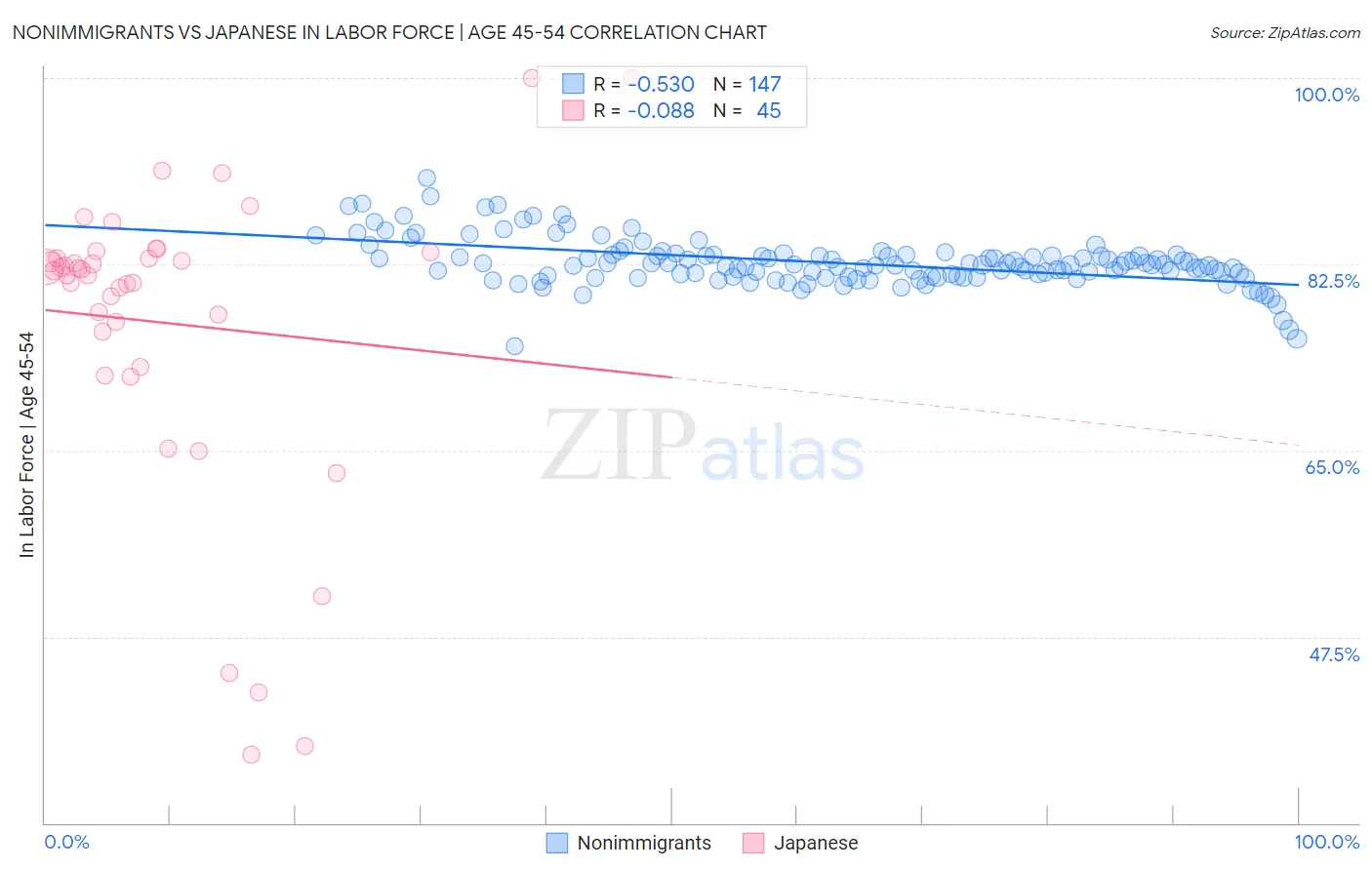Nonimmigrants vs Japanese In Labor Force | Age 45-54
COMPARE
Nonimmigrants
Japanese
In Labor Force | Age 45-54
In Labor Force | Age 45-54 Comparison
Nonimmigrants
Japanese
81.2%
IN LABOR FORCE | AGE 45-54
0.0/ 100
METRIC RATING
275th/ 347
METRIC RANK
81.6%
IN LABOR FORCE | AGE 45-54
0.2/ 100
METRIC RATING
253rd/ 347
METRIC RANK
Nonimmigrants vs Japanese In Labor Force | Age 45-54 Correlation Chart
The statistical analysis conducted on geographies consisting of 584,054,768 people shows a substantial negative correlation between the proportion of Nonimmigrants and labor force participation rate among population between the ages 45 and 54 in the United States with a correlation coefficient (R) of -0.530 and weighted average of 81.2%. Similarly, the statistical analysis conducted on geographies consisting of 249,074,736 people shows a slight negative correlation between the proportion of Japanese and labor force participation rate among population between the ages 45 and 54 in the United States with a correlation coefficient (R) of -0.088 and weighted average of 81.6%, a difference of 0.47%.

In Labor Force | Age 45-54 Correlation Summary
| Measurement | Nonimmigrants | Japanese |
| Minimum | 74.9% | 36.4% |
| Maximum | 90.6% | 100.0% |
| Range | 15.7% | 63.6% |
| Mean | 82.6% | 77.0% |
| Median | 82.4% | 81.9% |
| Interquartile 25% (IQ1) | 81.3% | 74.5% |
| Interquartile 75% (IQ3) | 83.3% | 83.3% |
| Interquartile Range (IQR) | 2.1% | 8.8% |
| Standard Deviation (Sample) | 2.3% | 14.4% |
| Standard Deviation (Population) | 2.3% | 14.3% |
Similar Demographics by In Labor Force | Age 45-54
Demographics Similar to Nonimmigrants by In Labor Force | Age 45-54
In terms of in labor force | age 45-54, the demographic groups most similar to Nonimmigrants are British West Indian (81.2%, a difference of 0.010%), Chippewa (81.3%, a difference of 0.040%), U.S. Virgin Islander (81.2%, a difference of 0.040%), Guatemalan (81.2%, a difference of 0.060%), and Spanish (81.3%, a difference of 0.10%).
| Demographics | Rating | Rank | In Labor Force | Age 45-54 |
| Immigrants | Honduras | 0.0 /100 | #268 | Tragic 81.4% |
| Alsatians | 0.0 /100 | #269 | Tragic 81.3% |
| Bangladeshis | 0.0 /100 | #270 | Tragic 81.3% |
| Immigrants | Barbados | 0.0 /100 | #271 | Tragic 81.3% |
| Spanish | 0.0 /100 | #272 | Tragic 81.3% |
| Chippewa | 0.0 /100 | #273 | Tragic 81.3% |
| British West Indians | 0.0 /100 | #274 | Tragic 81.2% |
| Immigrants | Nonimmigrants | 0.0 /100 | #275 | Tragic 81.2% |
| U.S. Virgin Islanders | 0.0 /100 | #276 | Tragic 81.2% |
| Guatemalans | 0.0 /100 | #277 | Tragic 81.2% |
| Immigrants | Guatemala | 0.0 /100 | #278 | Tragic 81.1% |
| Immigrants | Micronesia | 0.0 /100 | #279 | Tragic 81.1% |
| Immigrants | Latin America | 0.0 /100 | #280 | Tragic 81.0% |
| Immigrants | Grenada | 0.0 /100 | #281 | Tragic 81.0% |
| Aleuts | 0.0 /100 | #282 | Tragic 81.0% |
Demographics Similar to Japanese by In Labor Force | Age 45-54
In terms of in labor force | age 45-54, the demographic groups most similar to Japanese are Immigrants from Laos (81.6%, a difference of 0.010%), Scotch-Irish (81.6%, a difference of 0.020%), Pennsylvania German (81.6%, a difference of 0.030%), Guamanian/Chamorro (81.6%, a difference of 0.040%), and Barbadian (81.6%, a difference of 0.050%).
| Demographics | Rating | Rank | In Labor Force | Age 45-54 |
| Alaskan Athabascans | 0.4 /100 | #246 | Tragic 81.8% |
| Central Americans | 0.4 /100 | #247 | Tragic 81.7% |
| Puget Sound Salish | 0.3 /100 | #248 | Tragic 81.7% |
| Hmong | 0.3 /100 | #249 | Tragic 81.7% |
| Immigrants | Armenia | 0.2 /100 | #250 | Tragic 81.7% |
| Guamanians/Chamorros | 0.2 /100 | #251 | Tragic 81.6% |
| Pennsylvania Germans | 0.2 /100 | #252 | Tragic 81.6% |
| Japanese | 0.2 /100 | #253 | Tragic 81.6% |
| Immigrants | Laos | 0.2 /100 | #254 | Tragic 81.6% |
| Scotch-Irish | 0.2 /100 | #255 | Tragic 81.6% |
| Barbadians | 0.1 /100 | #256 | Tragic 81.6% |
| Immigrants | Congo | 0.1 /100 | #257 | Tragic 81.6% |
| Immigrants | Fiji | 0.1 /100 | #258 | Tragic 81.5% |
| Guyanese | 0.1 /100 | #259 | Tragic 81.5% |
| Spaniards | 0.1 /100 | #260 | Tragic 81.5% |